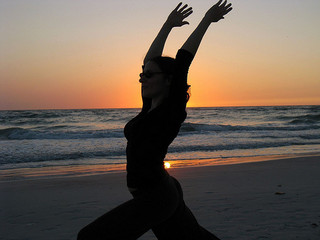 After experiencing a migraine, the last thing you want to do is even think about exercise. Often, chronic migraine sufferers fear that exercise may induce symptoms. It can be difficult to motivate yourself to exercise when you are afraid of another migraine episode.
After experiencing a migraine, the last thing you want to do is even think about exercise. Often, chronic migraine sufferers fear that exercise may induce symptoms. It can be difficult to motivate yourself to exercise when you are afraid of another migraine episode.
Scientific research has increasingly shown that regular physical movement is an important part of a healthy lifestyle that helps to reduce the risk of almost all disease, and if done with caution and moderation, it can be beneficial for migraine sufferers. Read below for tips on the two best types of exercises to reduce migraine frequency, as well as exercises to avoid or modify.
Strike a Pose
One of the best places to begin adding movement to your daily activities is by starting a regular yoga practice. By enjoying a series of gentle poses just a few times a week, you can begin to experience the increased mobility, decreased stress response, and calmer mindset that comes with practicing yoga. Many yogis swear that their migraine episodes have dramatically decreased, thanks to their practice. But how does yoga help decrease the frequency or severity of migraines?
One particular theory of how migraines occur suggests that the arteries that supply the brain with blood undergo a temporary narrowing during a migraine, often due to stress or muscle tension. The change in pressures causes the blood vessels of the brain to painfully dilate. Baxter Bell, M.D., who specializes in medical applications of yoga, explains that keeping your body’s nervous system more relaxed on a daily basis can reduce the potential narrowing of blood vessels and therefore the chance of experiencing a migraine. Yoga’s relaxing effect makes it an ideal candidate for reducing migraines.
To get started, choose gentle poses that keep your head above your heart, and avoid straining or holding your breath. Focus on breathing slowly and deeply in each posture before moving on to the next. Poses like seated twists, reclining leg stretches, and supported forward folds will encourage your nervous system to relax, and may improve your chances of staying migraine-free for longer durations.
Step On Out
The American College of Sports Medicine recommends that adults enjoy 30-60 minutes of moderate exercise 5 times a week. This amount can seem overwhelming, but making simple choices throughout your day that increase your activity level can reduce your risk of heart disease and diabetes. Furthermore, moderate intensity exercise was recently shown to either have no effect or a slightly therapeutic effect on migraine sufferers, according to a recently published scientific study.
Exercise also boosts mood and increases relaxation, meaning that you are less likely to suffer from stress-induced migraines. However, when exercising, make sure that you have eaten a healthy snack beforehand, that you stay hydrated throughout exercise, and that you avoid your preexisting triggers, such as light, sound, or overexertion.
Focus on maintaining a moderate intensity, and slow down when you need to. Tools such as the Rate of Perceived Exertion scale, or a heart rate monitor, can help you monitor your intensity and stay in a safe zone. Stick to lighter weights if you are strength training, since extremely heavy lifting can cause migraine symptoms. Fun activities that can be done at a moderate rate include cycling, taking a brisk walk with a friend, or taking a leisurely swim at the pool.
The Bottom Line
Adding yoga or subtle physical exercise to your weekly routine will not only help you get fit and happy, but it may help reduce the frequency of your migraines. Choose calming activities like yoga or moderate intensity exercises to start reaping the benefits of a healthy lifestyle while reducing your susceptibility to migraines.
What is your favorite calming exercise? Share your tips for minimizing your risk of exercise-induced migraine symptoms and your insights on exercise and staying active.

